Small business commercial and industrial (C&I) loan balances increased year-over-year in the first quarter of 2020 for the third consecutive quarter, but continued to lag growth in total loans and C&I borrowings. Survey data indicated that new small business C&I lending increased slightly in the first quarter after declining in the fourth quarter of 2019. While aggregate credit line usage remained relatively stable, about 20 percent of respondents, on net, indicated increased credit line usage. Most of the 113 respondents to the Federal Reserve’s Small Business Lending Survey reported that application approval rates remained stable, but nearly 19 percent, on net, indicated a decline in credit quality amid tightening credit standards and loan terms. Additionally, over 70 percent of respondents answering a special question related to the COVID-19 pandemic cited the use of loan deferments or participation in the Paycheck Protection Program as tools utilized to mitigate the effects of the crisis.
Chart 1: Small Business C&I Loan Balances Increase Year-Over-Year and Quarter-Over-Quarter
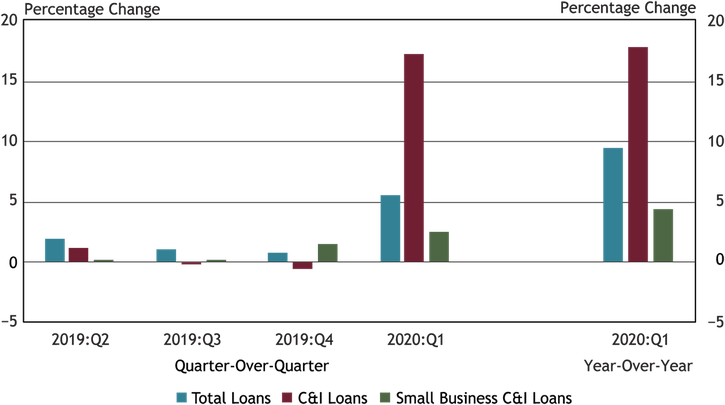
Note: Items are calculated using a subset of respondents that completed the FR 2028D for the last five quarters surveyed.
Sources: Call Report, schedule RC-C, items 4 and 12; and FR 2028D, items 4.b and 5.c.
Outstanding small business C&I loan balances increased in the first quarter compared with the prior quarter and the same period year-over-year. The increase in small business C&I loan balances continued to lag the growth of total loans and C&I loans. Compared with the prior quarter and the first quarter of 2019, small business C&I loans increased 2.5 and 4.4 percent, respectively, while total C&I loans increased 17.4 and 18.1 percent, respectively.
Chart 2: Outstanding Small Business C&I Loan Balances Increase for Midsized and Large Banks
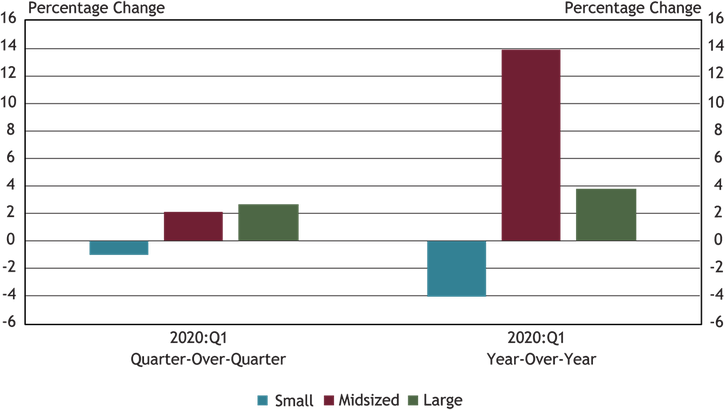
Note: Items are calculated using a subset of respondents that completed the FR 2028D for the last five quarters surveyed. Small banks have total assets of $1 billion or less, midsized banks have assets between $1 billion and $10 billion and large banks have assets greater than $10 billion.
Source: FR 2028D, items 4.b and 5.c.
Outstanding small business C&I loan balances increased for midsized and large banks quarter-over-quarter and year-over-year, and decreased for small banks over the same periods. Compared with the prior quarter, outstanding small business C&I loan balances increased in the first quarter by 2.1 and 2.7 percent for midsized and large banks, respectively. Midsized banks reported the largest year-over-year increase of 13.8 percent. Outstanding small business C&I loan balances decreased for small banks by 1.0 percent quarter-over-quarter and 4.0 percent year-over-year.
Chart 3: New Small Business C&I Term Loans Increase Year-Over-Year
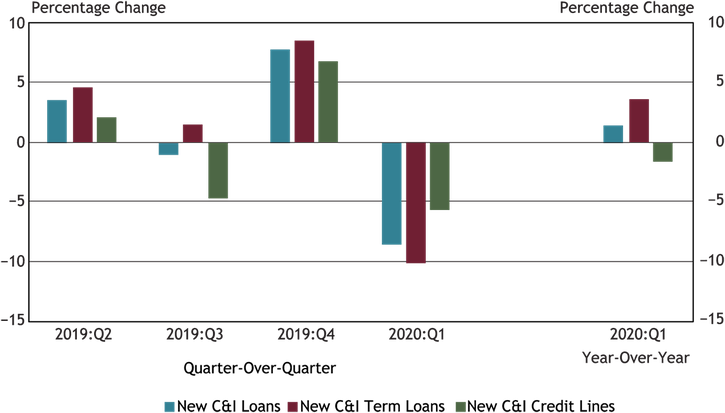
Note: Items are calculated using a subset of respondents that completed the FR 2028D for the last five quarters surveyed. All loan types referenced in Chart 3 refer to small business lending.
Source: FR 2028D, items 7.b and 10.c.
New small business C&I loans increased 1.6 percent compared with the first quarter of 2019, buoyed by an increase in new C&I term loans of 3.6 percent that offset a 1.6 percent decline in new C&I credit lines. Compared with the previous quarter, new small business C&I loans decreased 8.4 percent, with new C&I term loans and credit lines decreasing 10.1 and 5.6 percent, respectively.
Chart 4: Total Credit Line Usage Remains Stable
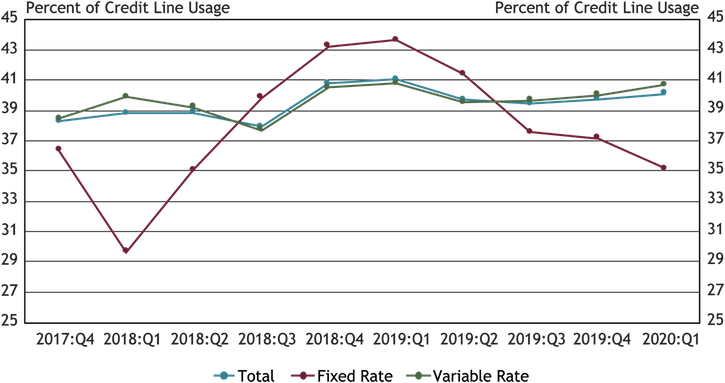
Source: FR 2028D, items 5.b and 5.c.
Total small business C&I credit line usage remained stable at 40.1 percent despite the continuing decline in fixed rate credit line usage that decreased from 37.2 percent in the fourth quarter of 2019 to 35.1 percent in the first quarter of 2020. Variable rate credit line usage increased slightly, from 40.0 percent in the fourth quarter to 40.7 percent in the first quarter. Compared with the first quarter of 2019, total credit line usage declined slightly from 41.1 percent to 40.1 percent, due primarily to a significant decrease in fixed rate credit line usage.
Chart 5: Interest Rates on Variable Rate Term Loans and Lines of Credit Decrease
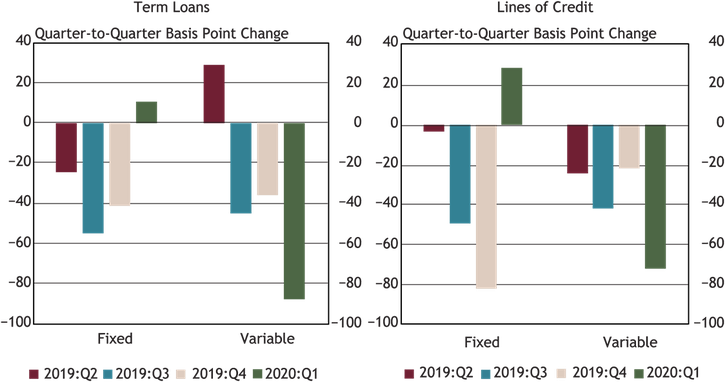
Note: Items are calculated using a subset of respondents that completed the FR 2028D for the last five quarters surveyed.
Source: FR 2028D, items 7.c and 10.d.
Weighted average rates on variable rate term loans and lines of credit decreased in the first quarter, while weighted average rates on fixed rate term loans and lines of credit increased. Weighted average rates on variable rate term loans and lines of credit declined by the largest margins in four quarters, falling 88 and 72 basis points, respectively. Weighted average rates on fixed rate term loans and lines of credit increased for the first time in four quarters, rising 10 and 29 basis points, respectively.
Chart 6: Interest Rates on New Small Business C&I Loans Less than Rates on Outstanding Small Business Loans
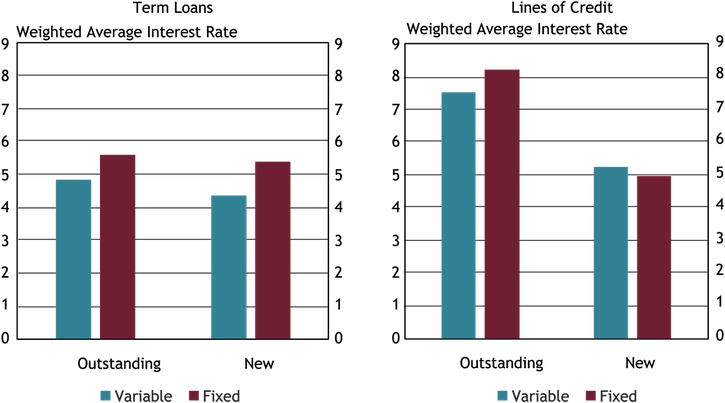
Note: Average interest rates are weighted by the dollar volume of new small business C&I loans.
Source: FR 2028D, items 4.c, 5.d, 7.c and 10.d.
Weighted average interest rates on variable and fixed rate new and outstanding small business C&I term loans and lines of credit ranged from 4.32 percent to 8.22 percent in the first quarter. The weighted average rates for new small business C&I term loans and lines of credit were consistently lower than the corresponding rates for outstanding small business C&I term loans and lines of credit. Weighted average variable and fixed rates on outstanding lines of credit were the highest, at 7.50 and 8.22 percent, respectively, while weighted average rates on new variable rate term loans and fixed rate lines of credit were the lowest at 4.32 and 4.96 percent, respectively.
Chart 7: New Small Business C&I Loans with Interest Rate Floors Decrease while Total Loan Balances at Interest Rate Floor Increase
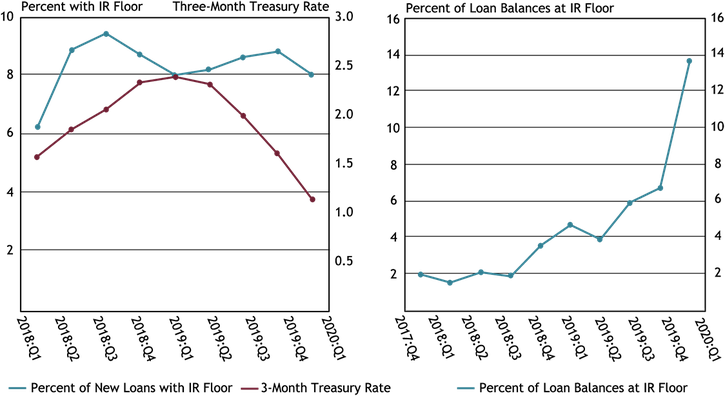
Source: FR 2028D, items 4.o, 5.n, 7.m, 7.o, 10.l, 10n.
The percent of new small business C&I loans with an interest rate floor decreased slightly in the first quarter to 8 percent, while the percent of total small business loan balances at the interest rate floor increased from 6.74 percent in the fourth quarter of 2019 to 13.7 percent in the first quarter of 2020. The increase in the percent of loan balances at interest rate floor is attributed primarily to the falling rate environment.
Chart 8: Respondents Report Increased Credit Line Usage
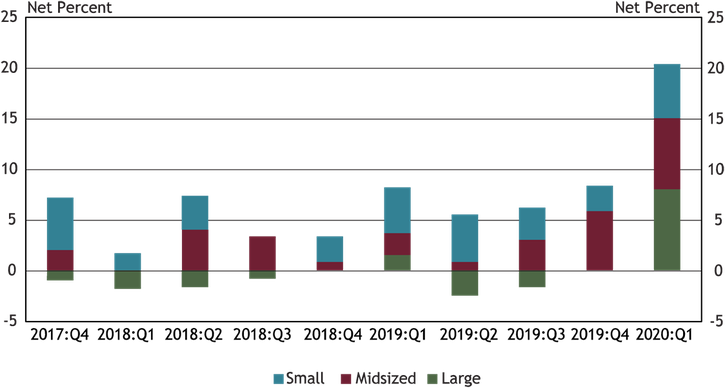
Notes: Chart 8 shows diffusion indexes for credit line usage. The diffusion indexes show the difference between the percent of banks reporting decreased credit line usage and those reporting increased credit line usage. Net percent refers to the percent of banks that reported having decreased (“decreased somewhat” or “decreased substantially”) minus the percent of banks that reported having increased (“increased somewhat” or “increased substantially”).
Small banks have total assets of $1 billion or less, midsized banks have total assets between $1 billion and $10 billion and large banks have total assets greater than $10 billion.
Source: FR 2028D, items 11 and 12.
On net, about 20 percent of respondents indicated that credit line usage increased in the first quarter, more than double the highest level since the inception of the survey. Net increases in credit line usage were reported for all bank sizes. The percentage of respondents indicating no change in credit line usage decreased from 78 percent in the fourth quarter to 62 percent in the first quarter. Of the banks reporting a change, whether an increase or decrease, 84 percent cited changes in national or local economic conditions as a very important reason for a change, and 65 percent cited change in borrower’s business revenue or other business specific conditions as a very important reason for a change.
Chart 9: Respondents Report Mixed Loan Demand
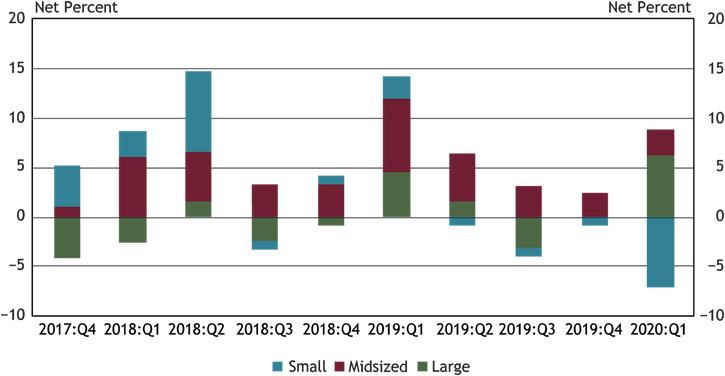
Notes: Chart 9 shows diffusion indexes for loan demand. The diffusion indexes show the difference between the percent of banks reporting weakened loan demand and those reporting stronger loan demand. Net percent refers to the percent of banks that reported having weakened (“moderately weaker” or “substantially weaker”) minus the percent of banks that reported having stronger (“moderately stronger” or “substantially stronger”).
Small banks have total assets of $1 billion or less, midsized banks have total assets between $1 billion and $10 billion and large banks have total assets greater than $10 billion.
Source: FR 2028D, item 13.
In the first quarter, about 16 percent of all banks reported a change in loan demand, the highest amount since the inception of the survey. The 6 percent of large banks and 3 percent of midsized banks reporting a net increase in loan demand was offset mostly by the 7 percent of small banks reporting a net decrease in loan demand. This was the fourth consecutive quarter in which small banks reported a decrease in loan demand.
Chart 10: Application Approval Rates Remain Relatively Stable
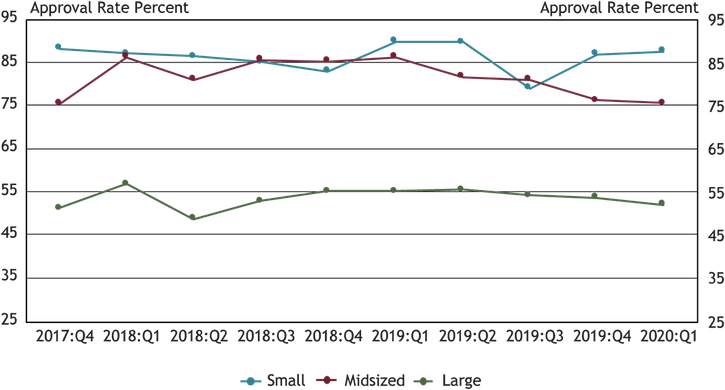
Note: Small banks have total assets of $1 billion or less, midsized banks have total assets between $1 billion and $10 billion and large banks have total assets greater than $10 billion.
Source: FR 2028D, items 14.a and 17.
Application approval rates for all bank sizes remained relatively unchanged in the first quarter. Approval rates for large banks decreased slightly to 52 percent, the lowest approval rate for large banks since the second quarter of 2018. Midsized banks also reported a slight decrease in approval rates from 76 percent in the fourth quarter of 2019 to 75 percent in the first quarter of 2020, equaling the lowest approval rate for midsized banks since the inception of the survey. The three most commonly cited reasons for denying a loan were borrower financials, credit history, and collateral.
Chart 11: Decreases Reported in Credit Quality across All Bank Sizes
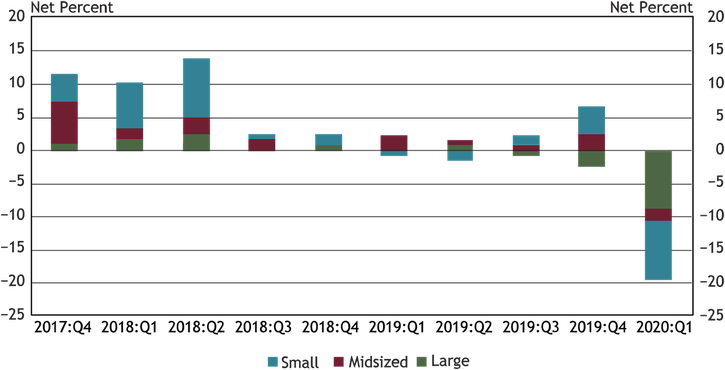
Notes: Chart 11 shows diffusion indexes for credit quality of applicants. The diffusion indexes show the difference between the percent of banks reporting a decline in credit quality and those reporting improvement in credit quality. Net percent refers to the percent of banks that reported declining credit quality (“declined somewhat” or “declined substantially”) minus the percent of banks that reported improving credit quality (“improved somewhat” or “improved substantially”).
Small banks have total assets of $1 billion or less, midsized banks have assets between $1 billion and $10 billion and large banks have assets greater than $10 billion.
Source: FR 2028D, items 24 and 25.
In the first quarter, about 19 percent of banks reported a net decrease in the credit quality of applicants, the largest decline since the inception of the survey and the first quarter in which all bank sizes reported a net decrease. Of the respondents reporting a change in credit quality, whether an increase or decrease, 53 percent cited prospects for business growth or enterprise values as a very important reason for a change. Other commonly cited reasons for a change include the liquidity position of business owners, debt-to-income level of business owners and recent business income growth.
Chart 12: Banks Tighten Credit Standards and All Loan Terms
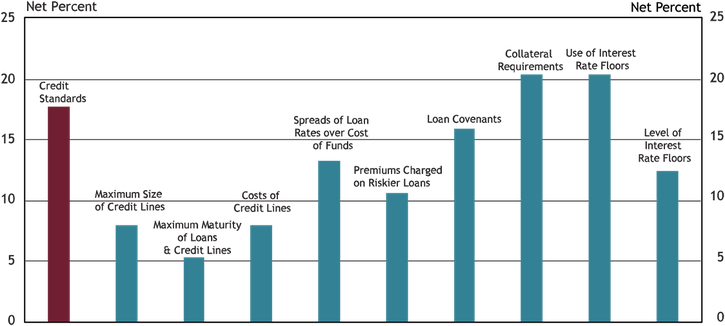
Note: Chart 12 shows diffusion indexes for credit standards (red bar) and various loan terms. The diffusion indexes show the difference between the percent of banks reporting tightening terms and those reporting easing terms. Net percent refers to the percent of banks that reported having tightened (“tightened considerably” or “tightened somewhat”) minus the percent of banks that reported having eased (“eased considerably” or “eased somewhat”).
Source: FR 2028D, items 18, 19, 20 and 22.
About 25 percent of respondents reported a change in credit standards in the first quarter, up about 16 percent from the fourth quarter of 2019. Of banks indicating a change in credit standards, 18 percent on net reported tightening their credit standards, an increase of about 14 percent from the previous quarter.
On net, respondents indicated that all loan terms tightened with use of interest rate floors, collateral requirements and loan covenants tightening the most. Respondents reporting tightening credit standards or loan terms in the first quarter cited a less favorable or more uncertain economic outlook and worsening industry specific problems.
Chart 13: COVID-19 Pandemic and its Impacts on Small Businesses
A special question in the first quarter Small Business Lending Survey asked: "How has the COVID 19 crisis impacted your bank’s small business customers and what steps has your bank taken to mitigate these impacts?” It should be noted that May was the data collection period for the survey. Responses to this special question may be more reflective of a point-in-time response rather than a response based on the impact faced by an institution on March 31, 2020. Sixty-five percent of reporting institutions provided an answer to the special question. Of those institutions that responded to the special question:
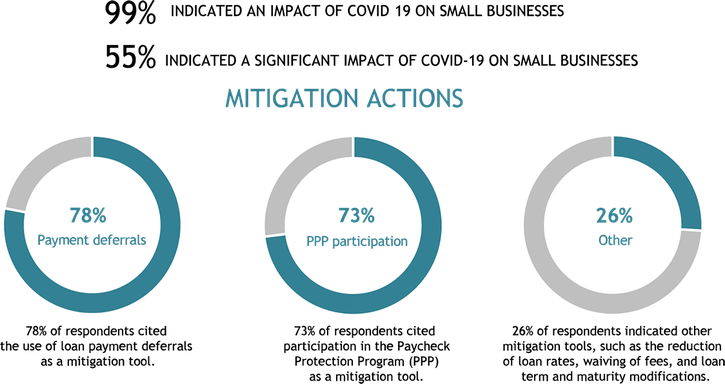
Other contributors to this release included Dan Harbour, Thomas Hobson, Alli Jakubek, Tony Walker, and Jim Wilkinson.
Contact Us
For questions or comments about this survey, contact us at KC SRM FR2028D Survey.
The views expressed are those of the authors and do not necessarily reflect the positions of the Federal Reserve Bank of Kansas City or the Federal Reserve System.
